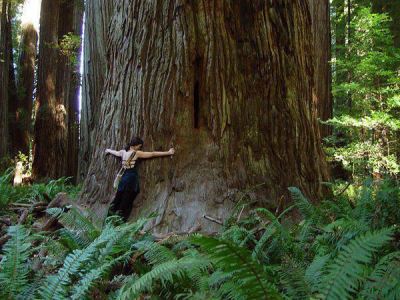“You have forsaken heaven to pay divine honor to earth.”
— Clement of Alexandria, “Exhortation to the Heathens”
Neo-Paganism is often described as an “Earth religion” or “nature religion.” It has been called “the Green Party at prayer.” Most Neo-Pagans practice an Earth-centered spirituality. For them, the quintessential component of a Neo-Pagan identity is the perception of the divine manifest in the physical world. Many Neo-Pagans are pantheists. Neo-Pagans valorize physical space as a vital element of spirituality and maintain a this-worldly focus in their religious lives. Modern life has the tendency to cut us off from kinship with the world of living nature, until we feel as if we are a cog in a great machine. Neo-Pagans seek to restore a sense of our oneness with nature. It is for this reason that Neo-Pagans celebrate the seasonal festivals called the “Wheel of the Year.”
The history of Neo-Paganism is part of a larger history of nature religion in the West, beginning with the American Transcendentalists and religiously-motivated conservationists like John Muir. These men and women appreciated a religious dimension to our relationship with the environment. The origins of Neo-Paganism in the late 1960s and early 1970s coincided with the growth of the environmental movement. Two of the first Neo-Pagan organizations in particular, Feraferia and the Church of All Worlds, both founded in 1967, intentionally styled themselves as nature religions, in contrast to the so-called “revealed” religions of Christianity, Judaism, and Islam.
“Feraferia is a fellowship for the religion of nature and the commonwealth of wilderness,” wrote Feraferia’s founder, Fred Adams. Adams was inspired by Thoreau and Muir, among others. In the first issue of the Feraferia newsletter, published in 1967, he explained:
“The only way to reunite [humankind] is to reunite [humankind] with nature. … When [humankind] forgets that [they are] an animal, [they also become] inhumane. [Humankind] will become humane toward [humans] only when [they become] humane toward all nature. The inner nature of [humankind] has been disastrously severed from the all-enveloping nature of wilderness.”
Adams sought to restore the “vital link between visionary nature within and ecological nature without.”
Similarly, the Church of All Worlds was described by one of its priests, Tom Williams, in this way:
“We are basically life-affirming and nature-oriented as opposed to the anti-life, spirit-oriented, anti-nature religions of the Judeo-Christian tradition … Hence the only word for us is Pagans—the lovers of trees, the mad dancers of moonlit groves, the reverers of our beloved Earth for the mere fact of intoxicating existence.”
In 1970, the same year the first Earth Day was celebrated, the founder of the Church of All Worlds, Oberon (then Tim) Zell, described a vision of Earth as a living planet, several years before James Lovelock’s Gaia Hypothesis was popularized. The Church of All Worlds membership application includes this affirmation:
“In dedication to the celebration of life in its many forms, I hereby declare my commitment to a way of life that is ethical, benevolent, humanistic, life-affirming, ecstatic and ecologically sane. I subscribe to means and methods that are creative rather than destructive, tolerant rather than authoritarian, gentle rather than violent, inclusive rather than exclusive. I pledge myself to harmonious eco-psychic awareness with the total biosphere of holy Mother Earth.”
 In the 1970s, Neo-Paganism was strongly influenced by the eco-feminist movement. Morgan McFarland, the founder of a gender-inclusive form of Dianic Witchcraft, explained:
In the 1970s, Neo-Paganism was strongly influenced by the eco-feminist movement. Morgan McFarland, the founder of a gender-inclusive form of Dianic Witchcraft, explained:
“A [Neo-]Pagan world view is one that says the Earth is the Great Mother and has been raped, pillaged, and plundered and must once again be celebrated if we are to survive. Paganism means a return to those values that see an ecologically balanced situation so that life continues and the Great Mother is venerated again. If nature disappears, all my spiritual efforts go up in smoke. Both ecology and [Neo-]Paganism seek a restoration of the balance of nature. If you’re not into ecology, you really can’t be into [Neo-]Paganism.”
One of the most visible exponents of an eco-feminist Neo-Paganism has been the writer and activist, Starhawk. She advocates direct political action as an expression of Neo-Pagan values. Starhawk herself has been involved in peace protests and anti-nuclear demonstrations, and has been arrested many times for her activism. Starhawk and Diane Baker founded the Reclaiming tradition to bring together the spiritual and the political. “We are called to act as if we truly believe that the Earth is a living, conscious being that we’re part of,” Starhawk declares.
Starhawk believes that Neo-Pagan spirituality is about getting your hands dirty—both figuratively and literally. She calls her religious practice “dirt worship,” and her first coven was called “Compost.” She counsels:
“Take your magical and spiritual practice outdoors. Keep on with your inward focused meditations—but also step outside and practice being present with all your senses, observing the natural world. Bring your magical awareness into the everyday acts we do to take responsibility for our impact on the planet. Making compost is a profoundly sacred act. When we become conscious of what we do with our wastes, when we learn to transform them into fertility, we also heal ourselves.
“Plant trees. Build soil. Grow food. Express your love of the Goddess with head and heart, but also with your hands. Put them into the dirt, and let them become her healing hands, transforming waste to food, regenerating life.”
In addition to ritual and seasonal celebrations, many Neo-Pagans express their spirituality through gardening, composting, permaculture, and other activities that promote sustainable living, as well as participation in political action against environmentally irresponsible actions of business, industry, and government.